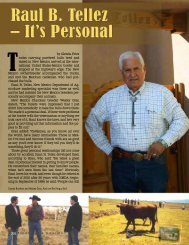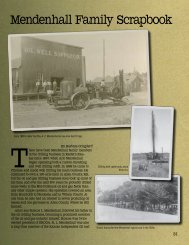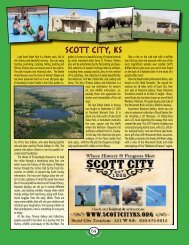Fort Dodge - Territorial Magazine
Fort Dodge - Territorial Magazine
Fort Dodge - Territorial Magazine
Create successful ePaper yourself
Turn your PDF publications into a flip-book with our unique Google optimized e-Paper software.
By Barbara Oringderff<br />
<strong>Fort</strong> <strong>Dodge</strong>, Kansas has never been “reconstructed”<br />
or “preserved” for the benefit of tourists. It is still in excellent<br />
shape after having been in continual use since it<br />
was established in 1865. Today, the fort’s first permanent<br />
buildings, constructed of native limestone and completed<br />
in 1867, are surrounded by well-manicured lawns<br />
and the atmosphere of a safe and friendly small town.<br />
T E R R I T O R I A L M A G A Z I N E<br />
47
Originally established<br />
as a supply<br />
depot and base of operations<br />
against the<br />
warring Plains Indians,<br />
<strong>Fort</strong> <strong>Dodge</strong> played<br />
an important part in<br />
shaping the history of<br />
the west. <strong>Fort</strong> <strong>Dodge</strong><br />
was truly an “Indian<br />
fort”, and from 1865<br />
to 1878 the men serving<br />
at the post were<br />
continually involved in<br />
scouting, marches and<br />
campaigns against the<br />
Indians. From 1867,<br />
when the Treaty of<br />
Medicine Lodge Creek<br />
was signed and <strong>Fort</strong><br />
<strong>Dodge</strong> became the<br />
northern boundary of<br />
the Indian Territories, This is the Custer House at <strong>Fort</strong> <strong>Dodge</strong>. Originally this was the commanding officer’s quarters<br />
until 1874, the fort was<br />
involved in several major campaigns<br />
to stop Indian depredations on the<br />
plains.<br />
In 1882 the frontier was considered<br />
closed and <strong>Fort</strong> <strong>Dodge</strong> was<br />
abandoned as a military post. On October<br />
2, 1882, the last troops to garrison<br />
<strong>Fort</strong> <strong>Dodge</strong> were ordered south to<br />
Camp Supply in Indian Territory, and<br />
the post was turned over to a caretaker<br />
appointed by the War Department.<br />
Finally, in 1889, the remaining<br />
acres of the military reservation (including<br />
the buildings) was purchased<br />
by <strong>Dodge</strong> City residents for $1.25 an<br />
acre and turned over to the state for<br />
use as a state soldiers’ home, which it<br />
remains today.<br />
Strangely enough, many of the<br />
people living at the fort, as well as<br />
most of the people in the surrounding<br />
area, don’t realize that we have a real<br />
Indian fort in our<br />
midst! One couple<br />
who came from Garden<br />
City to live at the<br />
fort, laughed when I<br />
told them that they<br />
were living in one of<br />
the oldest buildings<br />
in Western Kansas!<br />
“I would have never<br />
thought it,” she said,<br />
and I had to admit<br />
that you couldn’t really<br />
tell it by looking<br />
at their room. Nicely<br />
furnished and im-<br />
The old barn at <strong>Fort</strong> <strong>Dodge</strong>.<br />
maculately clean,<br />
the room in the old<br />
barracks, now called<br />
48 T E R R I T O R I A L M A G A Z I N E<br />
Nimitz Hall, looks like a modern<br />
apartment except for the three-foot<br />
deep windowsills in which she set<br />
her plants.<br />
The stone used to construct Nimitz<br />
Hall and the other original buildings<br />
at <strong>Fort</strong> <strong>Dodge</strong> was quarried from five<br />
to 10 miles north of the post. Sixty<br />
teamsters (both civilian and soldiers)<br />
and more than 200 mules were kept<br />
busy hauling the heavy stone from<br />
the quarry to <strong>Fort</strong> <strong>Dodge</strong>. Lieutenant<br />
George A. Hesselberger was in charge<br />
of the construction project, and he saw<br />
to it that the buildings were not only<br />
durable, but pleasing to look at. The<br />
stones were of varying lengths, but<br />
were cut to 18-inch heights and twofoot<br />
thickness and then dressed prior<br />
to their use. Each barrack was designed<br />
to hold a company of approximately<br />
50 men. The Negro troops of<br />
<strong>Fort</strong> <strong>Dodge</strong>, called “Buffalo Soldiers”<br />
by the Indians, were quartered in a<br />
separate frame building.<br />
During much of 1866 and 1867,<br />
Lieutenant Hesselberger complained<br />
to the Dept. of the Missouri that his<br />
construction project was being hampered<br />
by a shortage of both men and
shaken by his experience, asked that Douglass, the<br />
<strong>Fort</strong> <strong>Dodge</strong> commander, be censured for dereliction<br />
because too much money and manpower had been<br />
used for construction purposes while the frontier had<br />
obviously remained inadequately protected. In his<br />
report, he described the new buildings of <strong>Fort</strong> <strong>Dodge</strong><br />
as so magnificent and smoothly dressed that they<br />
“appeared to be designed for the National Capitol!”<br />
Major Douglass was later vindicated of any personal<br />
<strong>Fort</strong> <strong>Dodge</strong> Museum building<br />
The front of the <strong>Fort</strong> <strong>Dodge</strong> barracks<br />
building as it looks today.<br />
The native limestone building<br />
was completed in 1867, making<br />
it one of the oldest buildings in<br />
Western Kansas.<br />
material. Skilled carpenters, masons, blacksmiths, etc.<br />
were hard to find, and supply wagons headed for <strong>Fort</strong><br />
<strong>Dodge</strong> over the Santa Fe Trail were consistently attacked<br />
by the Indians. The work details sent out under military<br />
quart to quarry stone, cut firewood, etc, also were subject<br />
to continual harassment from Indians, and it was amazing<br />
that the men were able to finish the buildings at all.<br />
Lieutenant Hesselberger, however was not to get<br />
much praise for completing his project. In 1867, during<br />
General Hancock’s campaign to punish the hostile Indians,<br />
Inspector-General R. B. Marcy was dispatched<br />
to <strong>Fort</strong> <strong>Dodge</strong> to review the military situation along the<br />
Santa Fe Trail. As the general neared <strong>Fort</strong> <strong>Dodge</strong> he received<br />
a first hand demonstration of the garrison’s primary<br />
problem, when his wagon train was attacked by<br />
Indians and one of his officers killed. March, thoroughly<br />
<strong>Fort</strong> <strong>Dodge</strong> Post Office.<br />
responsibility regarding improper conduct relative to the<br />
erection of the new buildings, but Lieutenant Hesselberger,<br />
the officer directly responsible was called before a courtmartial<br />
hearing and dismissed from the service for misuse<br />
of government funds. The story goes that the dedication<br />
stones bearing Lieutenant Hesselberger’s name and the<br />
date the new buildings were completed (see photo above)<br />
were already set when the court-martial took place, and<br />
in recognition of his personal disgrace a buffalo robe was<br />
hung over each dedication stone.<br />
No buffalo skins hang over the stones today, and the<br />
beautifully kept buildings and grounds are open to the<br />
public year round. Don’t miss the fort’s great little museum<br />
or the house where General Custer stayed.]<br />
T E R R I T O R I A L M A G A Z I N E<br />
49









